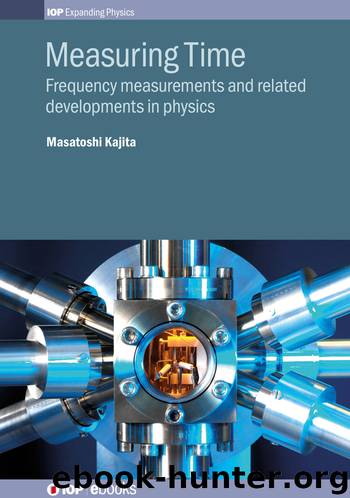Measuring Time: Frequency measurements and related developments in physics by Masatoshi Kajita

Author:Masatoshi Kajita
Language: eng
Format: epub
ISBN: 9780750321242
Publisher: IOP Publishing
Published: 2018-09-17T16:00:00+00:00
The Stark shift induced by, for example, the electric field produced by the probe laser and blackbody radiation, is much less than that for neutral atoms because energy gaps between the different electron states are much larger than those for neutral atoms. Moreover, the second-order Zeeman shift is less than 10−11 G−2; therefore, the Zeeman shift is negligibly small for sub-components where the first-order Zeeman shift is zero (M = 0).
There is a technical difficulty in controlling highly charged ions because the initial kinetic energy is of order 1 MK. Laser cooling of a highly charged ion is not realistic because the electron transition cannot be induced by laser light operating in the optical region. However, Ar13+ ions were cooled in interactions with laser cooled Be+ ions and trapped in a crystal [30].
Precise measurements of nuclear transition frequencies are also of interest. The energy gap between different nuclear states is much larger than that for atomic states because of the strong repulsive force between protons bounded in an area of femtometer size (figure 3.22). Most of the nuclear transition frequencies are in the γ-ray region, where frequency measurements are difficult. Nevertheless, the thorium-299 nucleus (299Th) has a transition in the vacuum ultra-violet (VUV) region (1.89 PHz, 159 nm). Such frequencies can be measured using a frequency comb [31]. With a suitably chosen electron state, this nuclear transition is free from the first-order Zeeman shift and the second-order Stark shift. Therefore, the systematic uncertainty is much lower than that for atomic transition frequencies.
Figure 3.22. Schematic of the nuclear structure. The strong repulsive forces between protons are bounded in an area five orders smaller than atoms.
Download
This site does not store any files on its server. We only index and link to content provided by other sites. Please contact the content providers to delete copyright contents if any and email us, we'll remove relevant links or contents immediately.
| Automotive | Engineering |
| Transportation |
Whiskies Galore by Ian Buxton(41937)
Introduction to Aircraft Design (Cambridge Aerospace Series) by John P. Fielding(33092)
Small Unmanned Fixed-wing Aircraft Design by Andrew J. Keane Andras Sobester James P. Scanlan & András Sóbester & James P. Scanlan(32763)
Craft Beer for the Homebrewer by Michael Agnew(18196)
Turbulence by E. J. Noyes(7977)
The Complete Stick Figure Physics Tutorials by Allen Sarah(7336)
Kaplan MCAT General Chemistry Review by Kaplan(6899)
The Thirst by Nesbo Jo(6877)
Bad Blood by John Carreyrou(6581)
Modelling of Convective Heat and Mass Transfer in Rotating Flows by Igor V. Shevchuk(6406)
Learning SQL by Alan Beaulieu(6237)
Weapons of Math Destruction by Cathy O'Neil(6214)
Man-made Catastrophes and Risk Information Concealment by Dmitry Chernov & Didier Sornette(5956)
Digital Minimalism by Cal Newport;(5704)
Life 3.0: Being Human in the Age of Artificial Intelligence by Tegmark Max(5512)
iGen by Jean M. Twenge(5384)
Secrets of Antigravity Propulsion: Tesla, UFOs, and Classified Aerospace Technology by Ph.D. Paul A. Laviolette(5332)
Design of Trajectory Optimization Approach for Space Maneuver Vehicle Skip Entry Problems by Runqi Chai & Al Savvaris & Antonios Tsourdos & Senchun Chai(5037)
Pale Blue Dot by Carl Sagan(4953)
